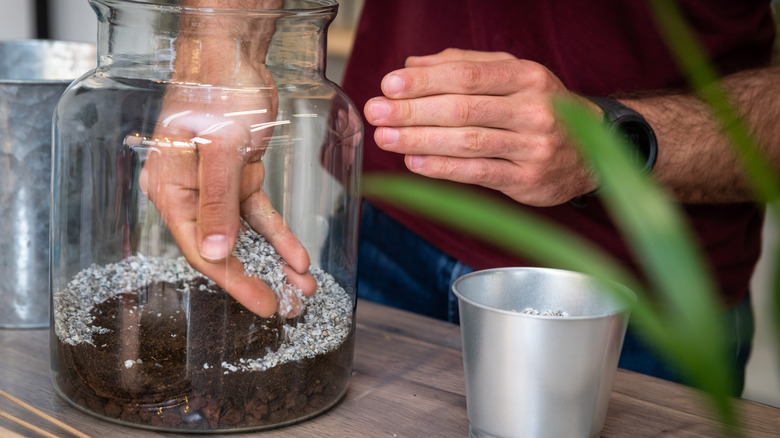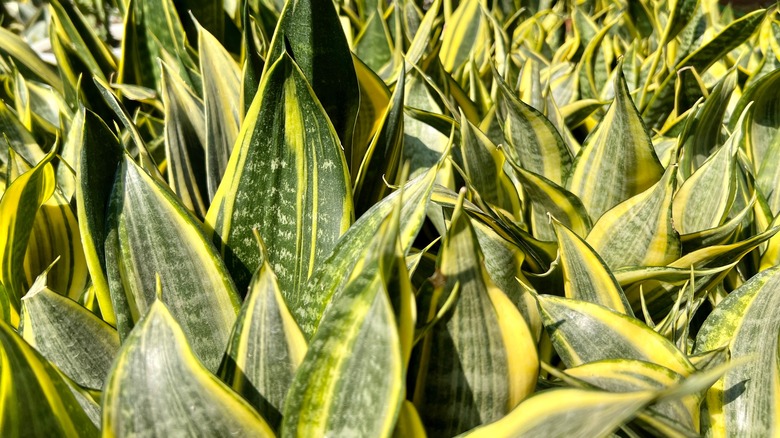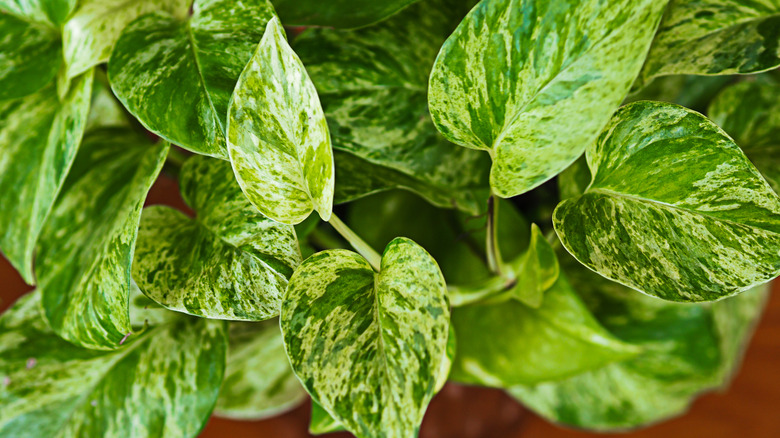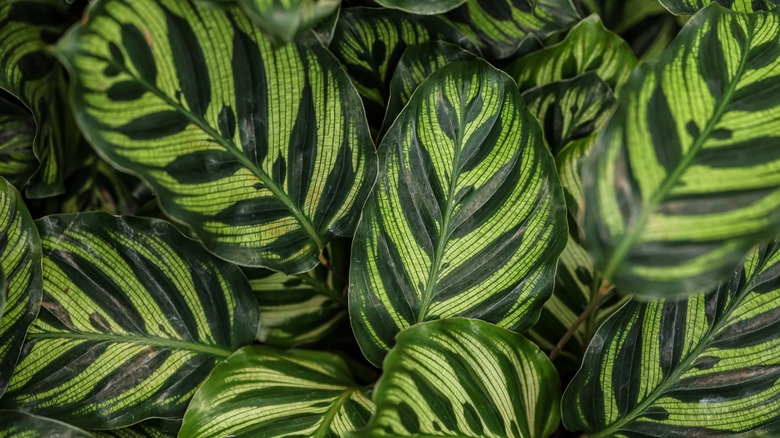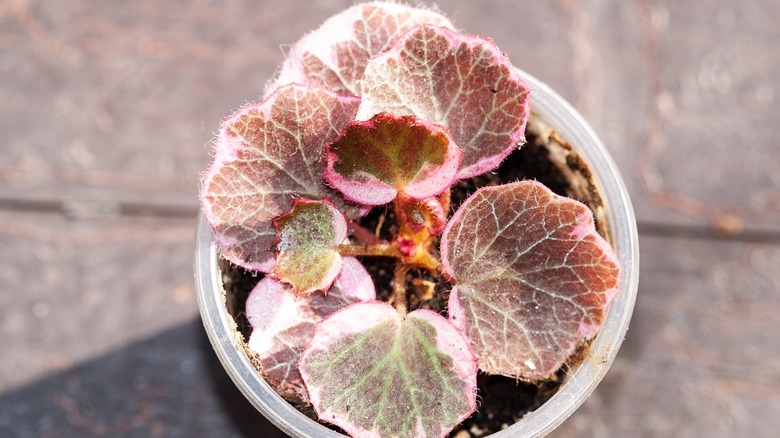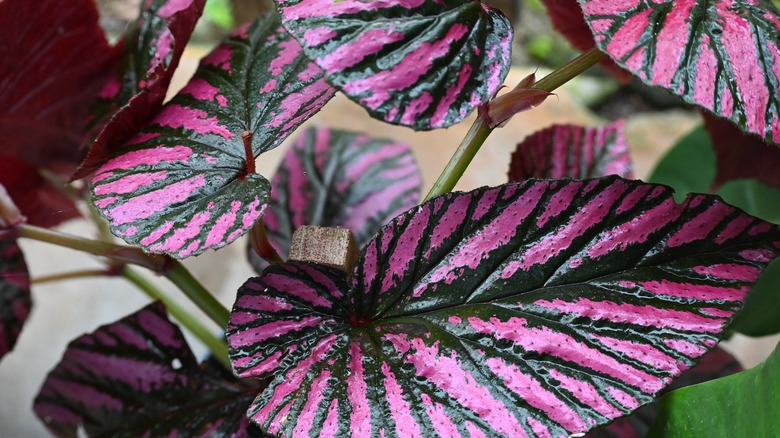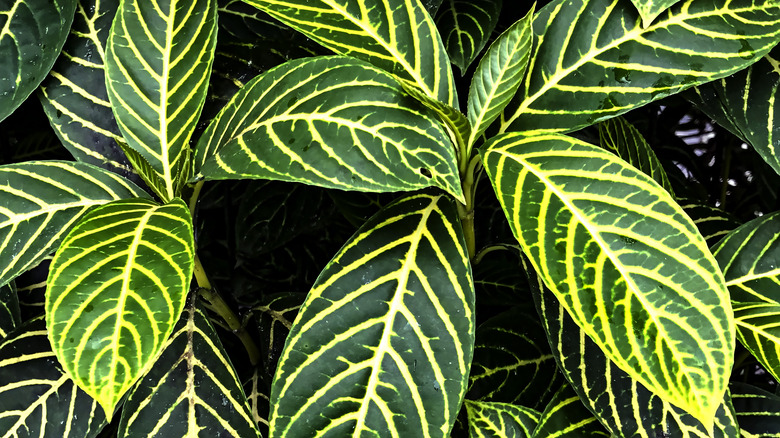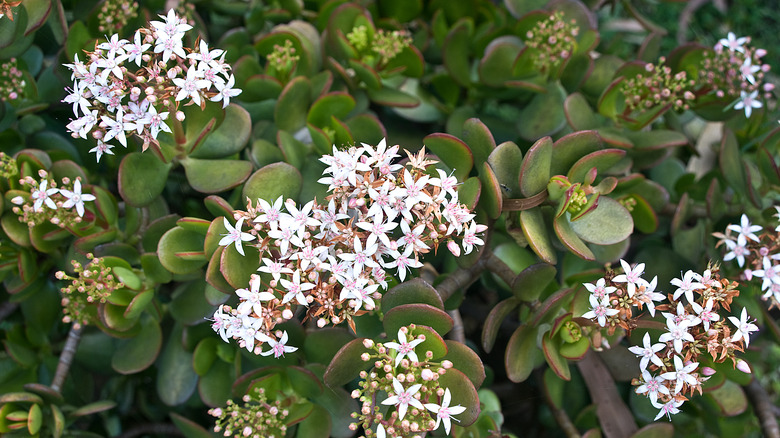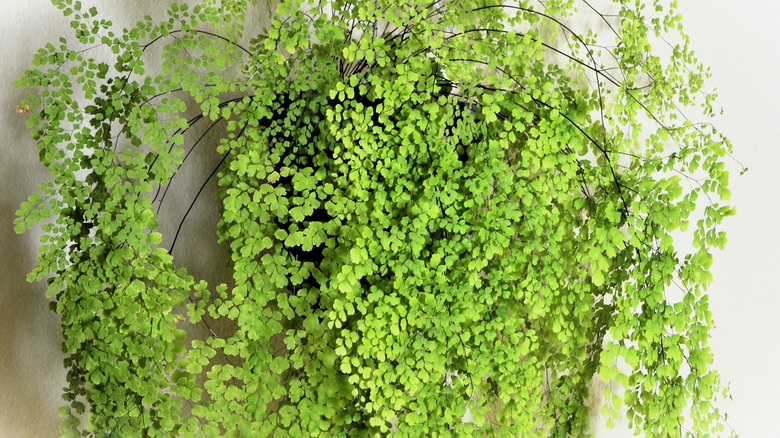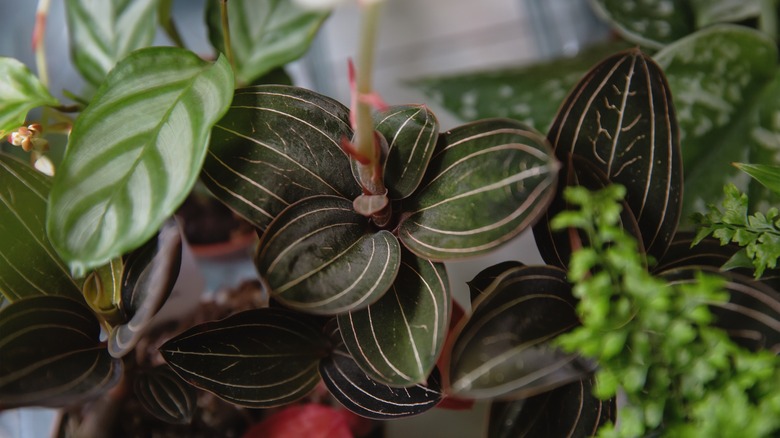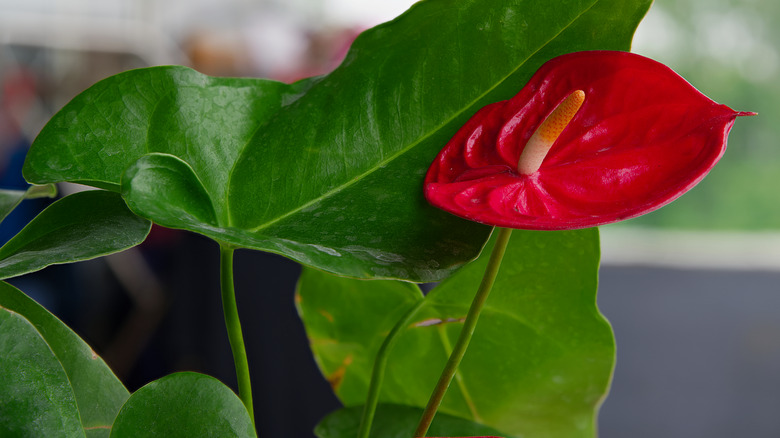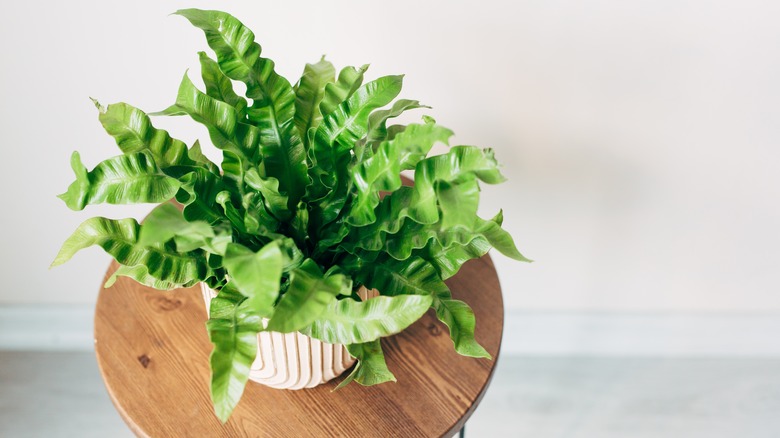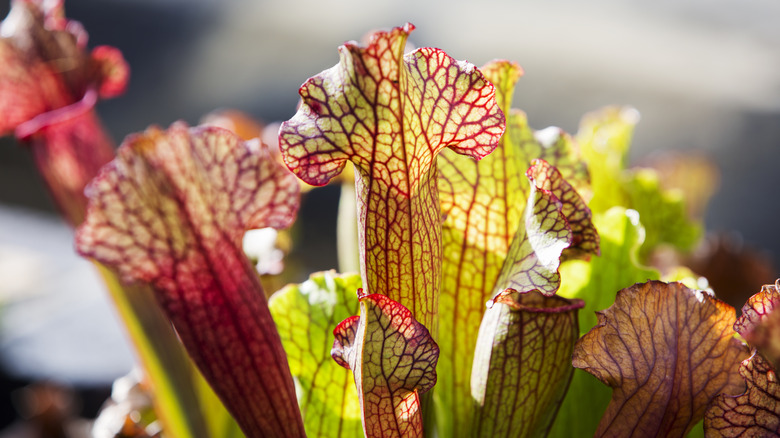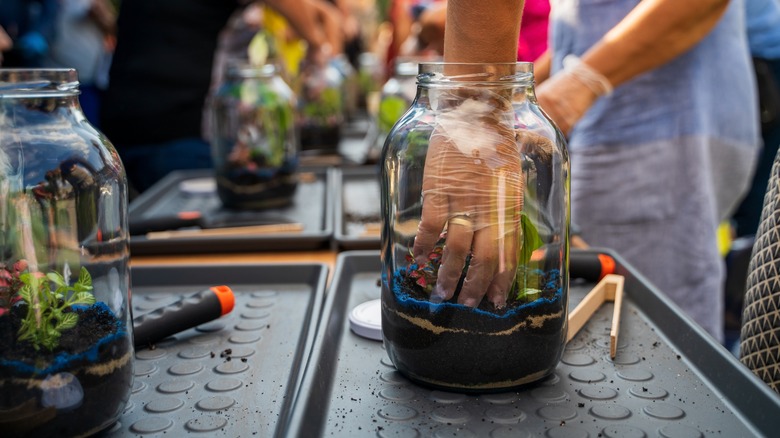12 Indoor Plants You Can Try To Grow In Jars (& Tips To Boost Success)
We may receive a commission on purchases made from links.
Sometimes, a jar is just too pretty to stash away in a cabinet. So why not use it to hold a plant? Traditional wisdom says plant pots need drainage holes. But don't feel like you need to break out your power drill and glass drill bits just yet. Instead, you could experiment with using houseplants that might handle living in a container without drainage.
A lack of drainage can spell disaster for many species, so we enlisted the advice of House Digest's resident plant expert, Tiffany Selvey, a master gardener with over a decade of experience and 200 educational hours in the field, to hone in on the houseplants that have the highest chance of surviving in jars. "These plants are the most tolerant of a wider range of growing conditions than more finicky plants that have very specific environmental demands," shared Selvey during an exclusive interview with House Digest.
To be clear, we're not talking about hydroponics, which are plants that live in water full-time, or temporarily water-propagating plant cuttings. Instead, these are mature plants that may be able to grow in jars filled with soil. To boost their chances of surviving, Selvey shares that "it's always better to underwater than overwater because it's much easier to slowly add more, but almost impossible to get it back out from a container with no drainage holes." In short, tailored watering is key, as too much will be a recipe for root rot. While it's not recommended to put plants in pots without drainage holes, with a careful watering regime and the right species, you may meet with success. Here are some potential plants to try for this zero-drainage experiment.
Snake plants can survive in almost any container, provided you don't overwater them
Dracaena trifasciata (more commonly known as the snake plant), is notoriously hardy, forgiving to grow, and drought tolerant – characteristics that make this popular houseplant a potential nominee for jars. Dweller of windowless office waiting rooms, thriver in that weird corner spot of your bathroom, and bringer of hope to even the most neglectful of plant parents, this succulent is native to the tropical climates of western Africa, is adaptable to most containers and can handle neglect without much issue. It can survive in low light conditions, but usually prefers somewhere that gets at least a few hours of indirect sunlight.
Despite its ability to go with the flow, though, there are some things to consider when putting your snake plant in a drainless jar. First, choose a potting mix that contains perlite or some additive that helps regulate moisture. As a succulent, snake plants are susceptible to root rot. To prevent this, Selvey advises, "Just add enough water to wet the surface of the soil to about an inch. You don't want any excess water around the roots of succulents. The nice thing about glass is you can see how far the moisture reaches without becoming excessive." Be sure not to pour water directly into the rosette and only water when you notice the first few inches of the potting soil is dry.
You'll also need to adjust your watering routine to the seasons as snake plants require less water in the colder months. If you mess up and accidentally heavily overwater, don't panic. Simply cut off any mushy parts and propagate the leaves in water. This is one of the best ways to propagate snake plants.
Pothos might happily grow in jars
The Pothos family of houseplants is famous for being one of the easiest plants anyone can keep alive thanks to its resilient nature. Selvey says that "pothos can tolerate a wide range of conditions," rendering it ideal for an experiment like planting in jars. The golden pothos (Epipremnum aureum) is a particular favorite for new plant parents with its gorgeous gold/green coloring and ability to handle most container situations. Plus, it's super easy to propagate a pothos via cuttings, making it a great way to create a thoughtful gift for fellow houseplant hoarders.
If you want to keep your golden pothos in a jar, there are a few things to consider. While pothos isn't a fussy plant, Selvey warns that "like most tropical plants, it thrives in consistently moist — but not soggy — soil." She also advises looking through the sides of the jar to gauge how much moisture is in the soil, adding that this is a top tip for any plant grown in a translucent jar. Similar to snake plants, you may want to reduce your watering during winter months while pothos is in its dormancy phase. If you want to really let your pothos flourish, put your jar on a shelf or bookcase, as this plant loves to trail its leaves, sometimes growing as long as 8 feet!
Peacock plants will strut their stuff in your prettiest jar
Peacock plants (or Goeppertia makoyana, reclassified from Calathea) are an ideal species for growing indoors, love humidity, and thrive in consistently moist soil, which makes them another potential pick for planting in glass jars. This eye-catching species is named after its gorgeous foliage which resembles a peacock's feathers that are in full presentation mode. Since it's part of the Marantaceae family, you'll notice it folds its leaves upwards at night, which is where it gets one of its other names: prayer plant.
While peacock plants like damp soil and humid conditions, this doesn't mean their feet should be waterlogged. Unfortunately, they are susceptible to root rot if things stay too wet for too long. To prevent this, use a growing medium that has lots of organic matter in it since this will let excess water drain to the bottom of the jar, away from the roots. Water in increments and with care to ensure the soil doesn't become waterlogged.
If you want to increase humidity in your home to make your houseplants happy, Selvey says, "A mini-humidifier would be excellent to provide extra humidity or you can spray the leaves a few times a week." Another trick is to place the peacock plant's pot over a dish that has water and gravel. Not only will the gravel and water dish increase humidity, but it will also help separate the plant a smidge from the rest of your collection. Giving your peacock plant a little space will let it spread out those amazing leaves and lower its risk of catching a mite infestation which can become a serious problem fast for this plant.
Strawberry geraniums can trail attractively from a jar
Strawberry geraniums (Saxifraga stolonifera) are another plant that likes their soil moderately moist, and this characteristic, combined with their low-maintenance, hardy nature, may allow them to handle living in a jar without drainage, as long as the soil doesn't become waterlogged. These fuss-free plants, sometimes referred to as strawberry begonias, are great for beginners because they rarely have problems with pests or diseases. Plus, their ability to spread out quickly (leading to their other name: mother of thousands) means you'll be able to have a stunning centerpiece plant in no time.
Because strawberry geraniums (like most plants) don't like to be waterlogged, the key to success is to water judiciously, being careful not to flood the jar. You should also use a well-draining soil mix. Saxifraga plants can survive in clay ground, but they do better in lighter mediums and a heavy clay blend might be too much, especially in a jar without drainage holes. Keep your Saxifraga away from harsh direct light, but still make sure the spot you choose gets at least a few hours of bright light. This stimulates the rich, red coloring its leaves get and may even help it produce a few flowers in the early summer months.
Rex begonias may love the moist soil a jar provides
Often described as adaptable and versatile, Selvey tells House Digest that "rex begonias are very tolerant of a wide range of conditions," and their easy-to-grow reputation could render these show-stoppers up to the challenge of living in a jar. There are few houseplants with leaves as stunning as a rex begonia. Their patterns range from swirls of white and green to speckled purple and reds. Native to the subtropical areas of Bhutan and northern Myanmar, these moisture-loving plants do very well in the most humid areas of your home, like bathrooms and kitchens. However, if you don't have a humid room that gets much sunlight, opt for using a gravel tray underneath your begonia instead to raise the humidity around it.
When it comes to the ideal watering routine for a rex, Selvey says that "like most plants, it's prone to root rot if the soil holds too much water." So while they aren't finicky, they won't enjoy a waterlogged jar. For best success, keep an eye on the moisture levels through the glass, allowing the top few inches to dry out (or the leaves to droop ever so slightly) before watering with a light hand. Rex begonias may also do better in shallow jars that are full of a chunkier, porous soil blend. Place it in an area that gets filtered light and rotate it weekly to ensure even growth.
A zebra plant might look phenomenal in a jar
The main reason zebra plants can be good candidates for jars lies in their moisture preferences: Selvey shares that zebra plants enjoy consistently moist soil, which is achievable in a glass jar, provided you bring your A-game when it comes to watering. In its native region of Brazil, the zebra plant (Aphelandra squarrosa) can grow up to 6 feet tall. Alas, as a houseplant, it won't reach those heights and will max out to around 2 feet. But don't get disappointed yet because its compact size as a domesticated part of your home is another reason it could be well-suited for jar life.
So how do you maintain perfectly moist soil for this attention-grabbing species? "Keeping an eye on the moisture level of the soil through the jar would be the best way to determine if it needs more water," says Selvey. To keep your Aphelandra squarrosa happy, don't let its growing medium dry out entirely, and use a blend that's designed to be well-draining. Also, since it's a tropical plant you should keep it somewhere that doesn't go below 65 degrees Fahrenheit. Domesticated zebra plants tend not to live as long as their other plant cousins, but it's very easy to propagate like a pro by trimming down leggy stems and putting them in water.
Jade plants can handle being a little neglected in jars
Jade plants can be another judicious choice for jars, thanks to their love of neglect, resilience to being root-bound, overall toughness, low-maintenance tendencies, and ability to go for extended periods without water. Most succulents prefer to be left alone and are often victims of being loved (and watered) a little too much by their plant parents. The jade plant (Crassula ovata), is more tolerant than its desert-based cousins, thanks to its ability to handle a wide array of temperatures and humidity levels. It's often used in open-system terrariums, handling the lack of drainage like a boss.
However, Selvey warns that "succulents are less tolerant of moist conditions and need the soil to dry out completely between waterings because they are quite prone to root rot when there's lack of drainage." She suggests dialing watering right back and letting the soil dry out as a way to protect jarred jade plants from root rot. To help combat any accidental overwatering, Selvey says, "I'd also recommend using soil specifically for succulents because it drains better than standard potting mix. An extra layer of pebbles at the bottom of the jar wouldn't hurt either."
If you don't have any succulent mix on hand, use very loose soil that contains sand, pea gravel, or perlite. Crassula ovata doesn't have a standard period of winter dormancy but would still prefer less water during the colder months. Prune it back in the spring to keep it compact and happy and only repot it in a bigger container every couple of years.
Maidenhair ferns should do fine with on-point watering
Although they can be somewhat finicky, these pretty plants could be a contender for jars. That's because, according to Selvey, "maidenhair fern is more tolerant than most when it comes to soggy soil." This ability to tolerate moist soil (to a degree) gives them a higher chance of handling accidental overwatering. Native to the U.S., these dainty ferns also make for ideal indoor plants, partly thanks to their attractive leaves and partly because they don't like direct sunlight.
Selvey advises that their soil should stay consistently moist, saying, "This is a plant; you should water any time the soil surface is dry." Besides disliking dry soil, maidenhair ferns also need relatively humid air conditions. If the air in your home is on the dryer side, consider investing in a small portable humidifier (these decorative ones on Amazon cost $16.92 for a set of two, don't require electricity, and would look right at home among some houseplants). As far as soil mediums go, maidenhair tends to prefer carbon-rich, well-draining substrates that are full of organic matter. Selvey says that a good houseplant potting mix is fine for these feathery ferns. Do not be heavy handed with fertilizers,as an overabundance of nutrients can actually be detrimental for fern species, and no drainage holes means you can't flush out the excess.
Jewel orchids are a great option for container planting
Because of their ability to handle zero-drainage situations like terrariums, and the fact that they're typically considered some of the easiest orchids to grow, jewel orchids may be a good bet for planting in jars, provided you don't overwater and create swamp-like conditions. Most orchids are too fussy for jars, preferring lots of drainage. The jewel orchids (like Macodes petola and Ludisia discolor), however, are a different beast altogether. They are terrestrial orchids, meaning these species grow on the ground, unlike their more commonly-known brethren, which use aerial roots to grow off of trees.
Jewel orchids prefer shallow containers, making them great for squat jars or even glass bowls. They like their soil to be constantly damp. Their roots don't grow deep, as their native habitat is under the forest canopies of Malaysia and New Guinea. They don't like direct sunlight and prefer shadier spots. Place your jewel orchid jar somewhere that has consistent temperatures and isn't full of drafts. If you obtain a gallon jar, you can even try growing this in a jar with a lid and create your own closed terrarium; just be sure the humidity stays between 60% and 85% to keep your orchid happy. You can also place a glass cloche (Amazon sells small cloches for under $40) over your potted jewel orchid to create a semi-closed environment that traps humidity.
You can counteract anthuriums' need for drainage with ultra-light soil
According to conventional wisdom, anthuriums should be one of the trickier species to grow without drainage, because they don't like waterlogged roots. But people have had anecdotal success growing anthuriums in glass jars and vases, which is why we've included them on this list. Furthermore, many anthurium species tend to be relatively hardy and easy to care for. They're one of the few houseplants that love high light conditions, making them great additions to a room with large windows that face west or south.
Selvey advises that "anthuriums do well in peat-based planting mediums because they like consistent moisture, but they also need good drainage." Perlite is another great addition to their soil, and anthuriums are often grown in 1:1 mixes of these two mediums. The reason why they love light growing mediums lies in the fact that the majority of this family are epiphytic, meaning they grow on trees rather than in the ground.
To help ensure the roots don't sit in water and instead get all the air they need, choose a deeper jar and fill it with your loose, light, peat- and perlite-based potting mix. These gorgeous plants will do best in jars that live in a room with relatively high humidity, at least 50%. Despite them appreciating bright light, make sure your anthuriums are not right in front of a window that gets harsh sunlight beating in, as direct light can burn their leaves.
Bird's nest ferns have compact root systems that jars can accommodate
Thanks to its relatively small root system, bird's nest fern (Asplenium nidus) might also do well in jars. Selvey tells us that this attractive species is a lot more tolerant of overly wet soil than many other plants, making occasional overwatering in zero-drainage containers less of a potential issue. This plant loves humidity and moist soil,and also has the interesting ability to create its own compost with its dead leaves, making it a plant that won't need much fertilizer from you.
As far as growing mediums for bird's nest ferns in jars go, Selvey says, "They don't need a special potting mix — anything high-quality for houseplants is fine." However, she also warns, "This is a plant that won't respond well to dry soil, so keep an eye on the jar and add water as needed to keep the roots happy." Despite it being a somewhat hardy fern, there are some further care requirements you'll need to stick to for it to thrive. The fronds of the bird's nest fern are fragile, so keep them away from drafts or playful cat paws. Give it lots of humidity, consider misting its leaves regularly, and place it near a north-facing window for optimal light levels. Asplenium nidus is not frost tolerant, especially as a houseplant, so make sure the room it's in doesn't dip below 50 degrees Fahrenheit.
Trumpet pitcher plants want the waterlogged conditions a jar provides
As a native bog species, carnivorous pitchers are one of the few plants you'll find that are practically tailor-made for growing without drainage. To put it in a nutshell, pitchers won't just tolerate, but may even prefer the waterlogged way of life that a jar offers. Although they do have certain unique requirements, trumpet pitchers (technically termed Sarracenia) are perhaps one of the easiest carnivorous species to grow, and are often recommended for first-time predator plant parents.
Typically grown in artificial bog gardens or potted and standing in trays of water, trumpet pitcher plants should never be allowed to dry out entirely. In fact, these enthralling predator plants can even handle flooded containers, as this mimics seasonal flooding that may occur in their native wetlands. However, having their roots and the pitcher base continually submerged in standing water isn't ideal. In jars, aim to be generous with watering, but do not keep the jar filled to the brim, as this could be detrimental. As far as soil goes, Selvey says, "A peat-based soil would be best for this kind of plant, but select something that doesn't have a lot of extra fertilizer as carnivorous plants prefer to get their nutrients from their prey." Do not add any additional fertilizer to the soil, and avoid hard water, as this can contain too many minerals for their taste. When it comes to placement, Selvey notes that "pitcher plants definitely like a lot of bright, indirect sunlight," so don't dump them in a dim corner.
A few tips for successfully potting houseplants into jars
Remember, while these plants may be more tolerant of moist conditions, it's still a best practice to provide drainage for most houseplants. But how can you do that with a solid-bottomed jar? If it's big enough, consider using a double-potting method where you place a pot with drainage holes inside the jar, creating a reservoir for excess water to escape. Tiffany Selvey also notes that "adding pebbles — like river rocks from the craft store — to the bottom of the jar will give excess water a place to go so it doesn't just sit around plant roots, leading to root rot."
According to Selvey, "The type of soil you use really depends on the plant. Some like consistently moist soil while others need to dry out between waterings. This is what makes growing in a jar with drainage difficult, but not impossible." As a general rule of thumb, it's a good idea to use a well-draining potting mix that contains organic additives like bark or coir to help regulate moisture and provide space around the roots for oxygenation. You can also experiment with potting mediums like LECA (aka clay pebbles, and available on Amazon for $23.99 for 10 pounds), LECHUZA-PON ($34.99 for 2.7 dry gallons), and lava rocks.
Also remember that you can't be too careful with your watering routine, as excess water won't be able to drain away and can cause a myriad of problems. Monitor the plants closely for any signs of stress, such as sad-looking leaves that are either drooping or turning yellow. It may seem like a lot of work, but once you get the hang of growing plants in jars, you'll become an expert plant parent in no time.
